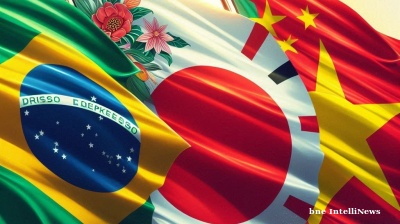Eastern Europe is in the midst of its annual winter freeze, but the seemingly intractable dispute over Ukraine’s eastern Donbas region may at last be starting to thaw. That is the conclusion many observers are drawing from a recent flurry of diplomatic activity in the region, including high-level meetings between Russian, Ukrainian and American leaders.
After nearly two years of war, a “frozen conflict” in the Donbas seemed like the best the region could hope for – better, at any rate, than the large-scale open warfare of 2014 and early 2015. In theory, the Minsk II deal that was signed in February 2015 should have led to a resolution of the conflict by the end of 2015. This second Minsk agreement called for an immediate ceasefire, constitutional reform in Ukraine providing for decentralization, local elections in the Donbas in accordance with Ukrainian law, and a return of control of the Russian-Ukrainian border to Ukrainian government forces.
Needless to say, none of that has happened. The ceasefire is mostly in place, though it is regularly violated. Ukraine’s constitution has yet to be amended, though the government has passed the first two of the three necessary readings. Elections in the Donbas have not occurred. And the border remains firmly under Russian control. The deadline for fulfilling the Minsk accords came and went, with both sides blaming the other for dragging their feet.
Given the deadlock, the Minsk discussions were extended into 2016, yet frozen conflict appeared to be the new status quo. The Donbas appeared to be headed toward a fate not unlike Transnistria in Moldova, or Nagorno-Karabakh in the South Caucasus – a war that was neither active, nor over.
Indeed, some people in Russia and Ukraine preferred conflict to peace. Many others supported the ceasefire, but were wary of a peace deal that included painful concessions. Many Ukrainians opposed reintegrating the Donbas if it meant providing special status to the region and letting separatist and pro-Russian forces re-enter the Ukrainian body politic. In Russia, meanwhile, a frozen conflict appealed to nationalist forces who feared a reintegration of the Donbas into Ukraine would amount to a sacrifice of the region’s ethnic Russians.
Despite the many groups arrayed against compromise, a series of diplomatic steps suggests a deal may, in fact, be in the works.
Gryzlov the grizzled bear
First, on December 26 Russian President Vladimir Putin named former Duma speaker and interior minister, Boris Gryzlov, as Russia’s new representative to the contact group on Ukraine. The appointment of Gryzlov, a political heavyweight, is evidence of renewed Russian interest in negotiations. Gryzlov’s appointment was also seen as a bureaucratic victory for Vyacheslav Surkov, a top Putin aide who is curating Russia’s policy toward the Donbas. The choice of Gryzlov meant that Ukraine policy would continue to be run directly out of the Kremlin rather than outsourced to the foreign ministry, whose professional diplomats would likely lack the political weight necessary to cut a deal.
Gryzlov began his work by declaring that Putin gave him the task of “doing everything necessary to conduct negotiations” regarding the conflict. Yet he also underscored the longstanding Kremlin line that Ukraine faced an “internal conflict”. Russia, he said, was “ready to undertake dialogue with representatives of both sides of the conflict” – that is, the government in Kyiv and the Donbas authorities – sidestepping the fact that Russia remains a key player in the conflict itself.
Gryzlov’s initial declarations, therefore, did not sound much different to the rhetoric of 2015 – rhetoric which had led to the frozen conflict but no stable peace. But his actions suggest a new interest in negotiations. In early January Gryzlov visited Kyiv, where he met with Ukrainian President Petro Poroshenko. In three hours of talks, Poroshenko and Gryzlov discussed the status of the Minsk deal, with Gryzlov reportedly asking whether Poroshenko would be capable of actually passing constitutional changes through the required third reading.
Days after Gryzlov’s visit to Kyiv, the US top diplomat working on the region, Victoria Nuland, met with Surkov in Kaliningrad. Nuland had previously conducted meetings with officials such as Deputy Russian Foreign Ministry Grigory Karasin several times in 2015, but Surkov is a much more direct channel to Putin.
Why the meeting? Surkov described the discussion as a “brain storm search for compromises for the realization of the Minsk agreements”. More specifically, he mentioned “constitutional reform, security, and elections” as the points that he and Nuland addressed.
The repeated mention of constitutional reform in the context of the Gryzlov-Poroshenko and Surkov-Nuland meetings is important. A key sticking point in previous rounds of talks was the meaning of “decentralization”, which is not spelled out in the Minsk agreement’s text. The Western powers argued that Kyiv’s proposed constitutional changes satisfied the Minsk requirements; the Kremlin disagreed. If the recent diplomatic activity leads to agreement on constitutional change, that would be a sign Ukraine’s frozen conflict may be starting to thaw.
Chris Miller is Associate Director of the Program in Grand Strategy at Yale University. Follow him on twitter @crmiller1
Opinion

COMMENT: Brazil’s Lula builds economic bridges across the Pacific
Brazil's President Lula boosted ties with Japan and Vietnam during his Asian tour last week, securing aircraft deals, beef markets and partnerships.

COMMENT: South Caucasus offers a potential diplomatic triumph for Trump
The new US administration wants to become the political team that ends the longstanding conflict between Armenia and Azerbaijan.

Emerging Europe risks being “cast adrift” from the West, think-tank warns
Ongoing geopolitical realignment accelerated by Trump’s return to office could plunge Emerging Europe into a cycle of instability and regional conflict, says a paper published by the ECFR.

BEYOND THE BOSPORUS: Damp squib
Turkey’s opposition seriously lacks imagination, as it showed today by moving the Free Imamoglu, Give Us Democracy street campaign to the periphery, much to the regime’s delight.




